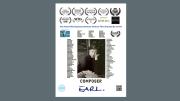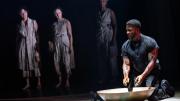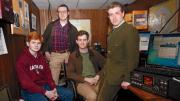If the Faculty of Arts and Sciences (FAS) approves an undergraduate concentration in “theater, dance, and media,” as expected later this semester, it will begin to fulfill a vision first outlined more than six years ago—or, depending on the historical narrative, as early as 1905. This dispatch
- summarizes the proposal being brought before the faculty by the Committee on Dramatic Arts, for a concentration melding analytical theater studies with performance-based classes (one step toward expanding performing arts in the curriculum generally), for discussion at the March 3 FAS meeting;
- examines what the proposal does and does not purport to do; and
- provides background on the evolution of this concentration and on the performing arts within the curriculum more generally.
The Proposed Concentration
As presented to the faculty, the concentration would require 11 half-courses (13 for honors candidates):
- Drama, Theater, Theory: a sophomore tutorial taught by the core faculty, introducing “a variety of theatrical forms, as well as…the fundamental tools of theatrical analysis.”
- A junior tutorial taught by graduate students and American Repertory Theater (ART) Institute graduate students or lecturers: small-group instruction (3-4 students) intended to integrate classroom study and studio practice.
- At least four courses on critical and scholarly approaches, taught by faculty members from humanities departments.
- At least four practice-based or studio courses, taught by ART and dance faculty, lecturers, professors of practice, or the English creative-writing faculty, covering directing, design, acting, dance choreography, playwriting, dramaturgy, and so on.
- Theater history: at least one course on various genres and forms of theater, dance, and media.
- Distribution requirement: At least one course, studio- or seminar-based, should focus on non-Western theater or non-traditional performance traditions.
- Participation requirement: Students must also participate in at least two departmental productions, and in two additional productions (departmental, or student-organized, extracurricular productions). There will be training modules in technical aspects of theater operations, such as running light boards or sound equipment. There are also two required theater labs: working on departmental shows in roles such as stage management, light and sound, wardrobe, and so on.
The honors thesis, a senior tutorial, can be performance-based or critical work.
What It Does
The concentration, as proposed, is structured like other nondepartmental degree programs, such as folklore and mythology and history and literature. Thus, it draws on existing instructional resources and courses (many of which are listed in the proposal, from freshman seminars through the current offerings in dramatic arts, a current secondary field).
The committee is careful to specify that “the principal goal of our art making is cognitive…guided art making is crucial for the generation of new ideas and thus serves an important pedagogical function.” The program deliberately melds “[t]ranslating reading, analysis, and research into art making” to engage “a different set of cognitive processes and disciplines” and thus enhance student understanding of material. The “practice-based work will happen in studio courses and departmental performances, allowing students to put professional training and historical research in a fruitful relation.”
The concentration is explicitly “not in the service of conservatory-style training.” Instead, it aims for “the type of creativity that is exercised in the triangle of research, training in art practice, and experimentation,” in a liberal-arts, rather than a professional-preparatory, context. The program’s chief goal is “to provide students with a deep understanding of the history of this important family of art forms as well as the intellectual traditions, from philosophy to criticism, that have developed around them.” (As part of the historical and critical work, the committee suggests, students and their professors might draw more heavily on the superb, but underutilized, Harvard Theatre Collection.)
The proposed concentration will be led by the FAS humanities departments, plus ART staff, dance center staff, and the faculty of Visual and Environmental Studies (VES).
What It Does Not Purport to Do
The new concentration does not create a new department (in contrast to most other universities, the proposal notes); a significant new cohort of ladder faculty members; or new facilities.
Although it is titled “theater, dance, and media,” the focus is solidly on theater. There will not be separate dance or media tracks; the media content and coursework derive from VES (where film, photography, and so on are based)—although such offerings are to be expanded; and, as the proposal notes, “Theatrical performance is…meant to serve as an umbrella term for our activities for the time being,” and students will be “exposed to all aspects of theater, dance, and newer media insofar as they relate to the former.”
The concentration is at pains not to supplant the rich, current extracurricular theatrical scene—a concern expressed by some students—and explicitly aims to collaborate with extracurricular performances (as noted above). The committee does propose that the concentration be based in Farkas Hall, and that it be responsible for “scheduling concentration events as well as non-concentration events.” (Farkas Hall, the “new college theatre,” is the modern performance venue created on the former site of the Hasty Pudding Theatricals headquarters.) That could become a possible point of strain, given the constraints already evident in booking space for performances.
Background and Context
According to the current concentration proposal:
In 1905, George Pierce Baker offered his first course in playwriting at Harvard and a few years later, he added a workshop for performances of the plays created in the course. Baker was one of the first professors to teach theater arts in the United States, and his efforts helped establish theater as a field of study both at Harvard and elsewhere. Since 1905 Harvard has come a long way. It boasts one of the premier theater companies in the country, the American Repertory Theater, the most extensive theater collection, and one of the most thriving student theater clubs, the Harvard-Radcliffe Dramatic Club.…
More recently, Harvard has made significant additional investments in theater, dance, performance, and media. Farkas Hall and 29 Garden Street offer new performance and studio spaces. The Office for the Arts has contributed significantly to the promotion of art making and has rebuilt the Dance Center, a crucial partner in the proposed concentration.
And yet, Harvard has been almost alone among its peers in treating these arts as primarily extra-curricular activities. Over the years, this has led to significant defections, including of George Pierce Baker himself, who went on to found the Yale School of Drama, now the leader in the field. The largely extra-curricular status of theater, dance, and media has also meant that generations of students interested in these areas have chosen our peer institutions, or they have created their own course of study through special concentrations.
Early in her administration, President Drew Faust chartered a Task Force on the Arts to address, comprehensively, how Harvard might expand in performing arts. When it analyzed drama, the task force concluded:
Harvard’s Dramatic Arts curriculum should require courses in theater history, literature, criticism and theory as well as practical courses in acting, directing, playwriting, and design. The concentration should integrate the scholarly perspective of the field with a serious practical training. Harvard should build on its strengths in dramatic literature in many languages and traditions, as well as the strengths of the play and screen writing courses within the English Department’s Creative Writing Program.…
The most appropriate model, it seems to us, is likely to be History and Literature…a free-standing concentration that draws upon the faculty and the curricular strengths of the relevant existing departments.…We do not…envision a course of study suitable for a conservatory; the concentration will be part of a liberal-arts education. But, as with many disciplines in the language arts or in the sciences, the acquisition of certain advanced skills will be crucial to the successful immersion in Dramatic Arts.
An unfortunate accident of timing caused those plans to be deferred: the task force reported in late 2008, just after the financial crisis that decimated Harvard’s endowment and turned administrators’ attention from prospects for University growth to sweeping measures to reduce costs and shore up the institution’s balance sheet.
But this is a new decade, and The Harvard Campaign brings new resources: as reported last October, Faust advanced funds to accelerate development of the concentration, with the details fleshed out along the lines the task force suggested—subject, of course, to FAS approval, as required for any academic program. Martin Puchner, Wien professor of drama and of English and comparative literature, is to bring the committee’s proposal before his colleagues for initial discussion March 3, preceding a likely vote later in the term. If the faculty approves, students could sign up for the concentration at the end of 2015.
In that context, the committee’s proposal, a long time coming, seems more than due. As it notes:
There has been talk of establishing a concentration focused on the performing arts ever since Baker left for Yale in 1925, and we feel that now is the time to anchor the theater arts, including dance and media, more fully in the curriculum.…For many decades, the Committee on Dramatic Arts has been supervising studio courses taught by the ART and dance faculty as well as visiting faculty and artists and has combined them with scholarly courses taught by colleagues in various humanities departments.…[T]he Committee has also offered a secondary field in Dramatic Arts, supplementing existing faculty strengths with visiting faculty…. Through these activities, the Committee on Dramatic Arts has gained the experience it needs to launch a concentration.
All that awaits is FAS approval, followed by student enrollment in the program.









